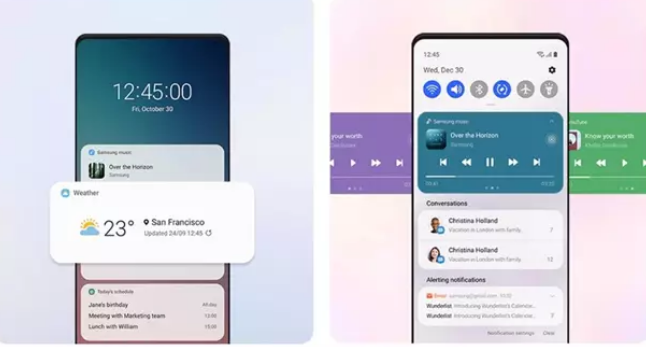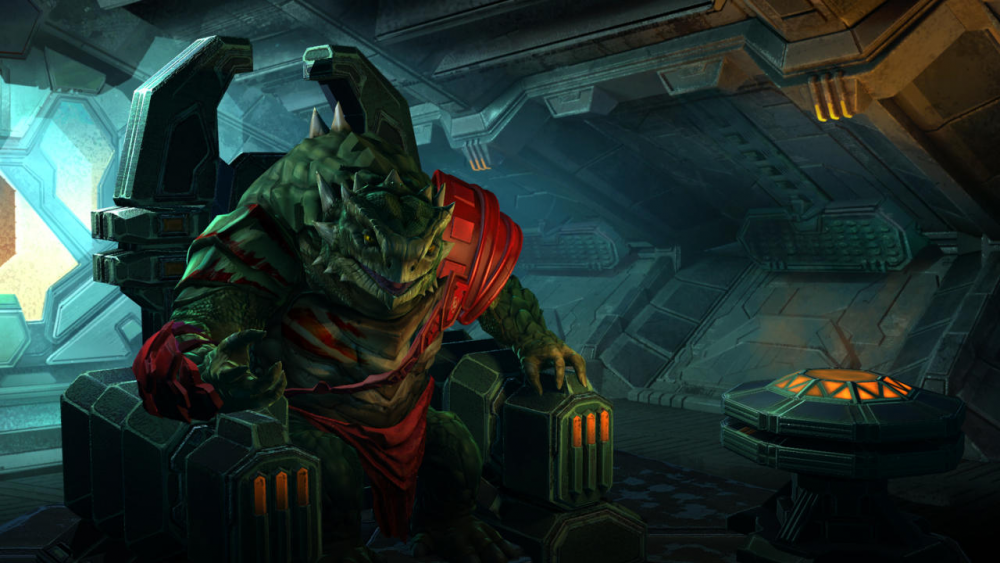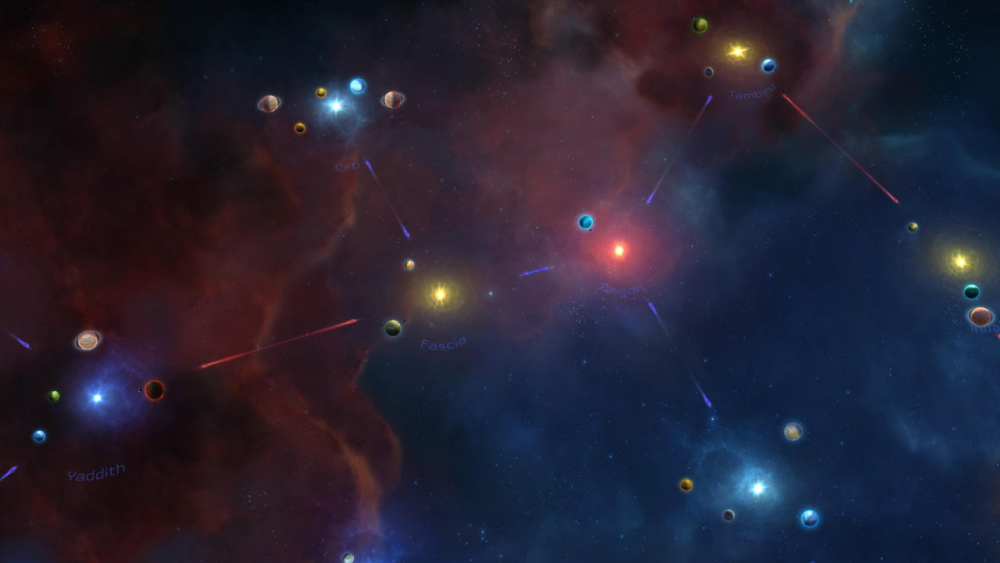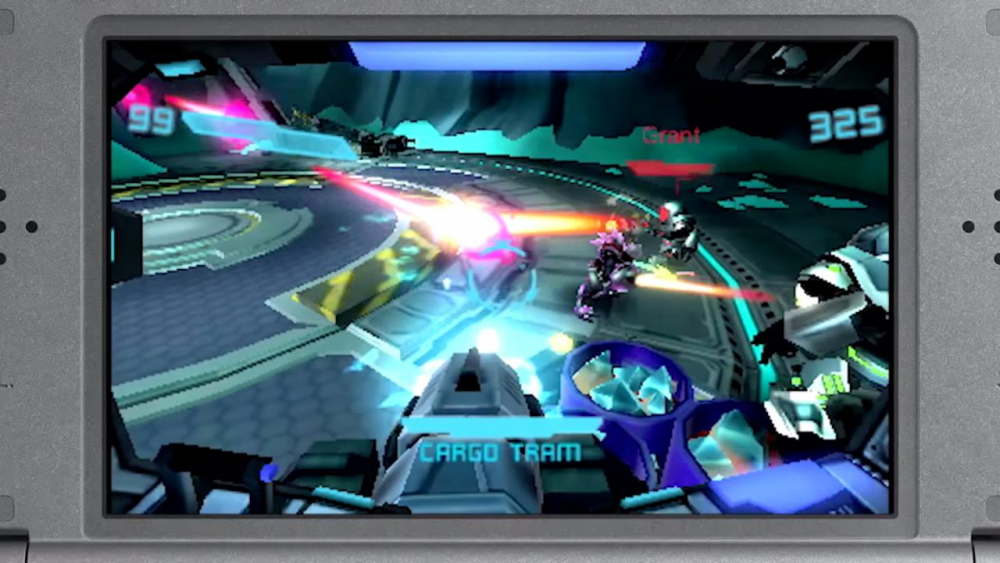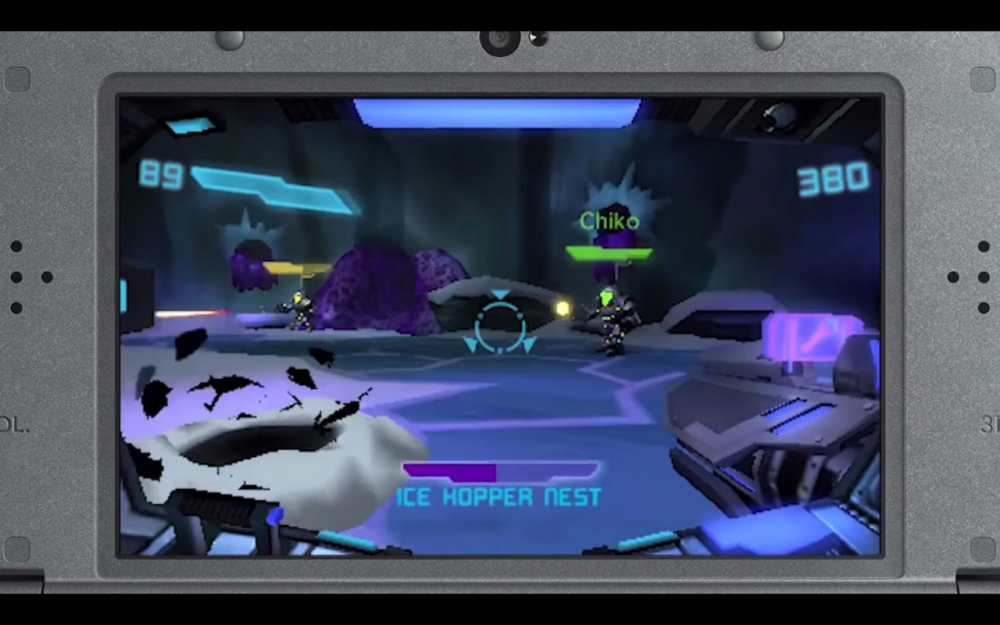Everything posted by Dark
-
Accepted!
-
-
Hello, please let the spammer comment on the seuong profile and avoid problems, read the rules and if you want an administrator on our servers, speak through private messages or request in the servers section.
for the next one she will be given a permanent banned in our community.
Thanks for your time
-
Samsung's One UI 3.0 software update based on Android 11 will begin rolling out in November to the company's high-end devices. Samsung announced the beta of One UI 3.0 in August, following the presentation of its new Galaxy Note 20 family. This 'software' based on Android 11 will begin to be distributed in November first in the Galaxy S20 devices and later the Note 20. The software website also indicates that this update will come to the Galaxy Fold and Z Fold 2 folding and the Galaxy Tab S7. One UI 3.0 introduces new features in Quick Settings, to "quickly" switch between music and videos, and notifications on the locked screen. In addition, it allows you to see the messages of different applications from the same place. This 'software' is optimized for different screen sizes, with the folding devices -Galaxy Fold and Z Fold 2- in mind, for a smooth transition from folded to unfolded format. It also includes support for the multi-active window, which divides the screen into two or three parts to use several applications simultaneously, and even choose which partition to place each 'app' on. In terms of photography, it offers new modes, such as the dual preview and the selfie with the rear camera for folding devices. It also supports full screen video calls.
-
- 5
-

-
In these times, being able to make a videoconference from home has become something not only common, but often necessary. There are not a few workers and even students who have had to get hold of a webcam to be able to attend to their work and educational needs, and for this reason if you have a Raspberry Pi collecting dust in a drawer, we are going to show you how you can turn it into a videoconference station simply, quickly and investing little money. The idea of this project is to dedicate a Raspberry Pi and certain accessories exclusively to mount a kind of video conference station, so that you do not have to use your PC or other devices for it. With tools such as Google Meet or Zoom and of course with the help of a Raspberry Pi and a webcam you will be able to keep in touch with people anywhere in the world, whether for work or study. Raspberry Videoconference What do you need to do a video conference on the Raspberry Pi? Next we are going to list the materials you will need, although keep in mind that these are our recommendations and of course you can change one or the other things depending on your needs and budget: A Raspberry Pi, preferably a Pi 4 with 8 GB since its SoC is much more powerful than previous models, and you will need this power for video encoding of video conferences. However, most models will work quite decently. An external monitor with speakers (an old TV but with HDMI would be ideal). USB keyboard and mouse. A USB webcam. You can also use the Raspberry Pi Camera if you have it. However, given the plug & play nature of USB devices, most webcams will work without a problem. Microphone. If your monitor does not have speakers you can use a headset with a microphone but that is USB instead. Configure the Raspberry Pi as a video conference station To get started, you need to install Raspberry Pi OS on your device. You can use other operating systems, but Chromium (built into Rasberry Pi OS) uses hardware acceleration, something that will greatly increase performance when making a video conference. The next step is to connect everything: the monitor via HDMI and the peripherals via USB. Obviously you must also connect your device to the network, either through an RJ-45 LAN cable or with a WiFi adapter, but the fact is that without Internet you will not be able to make videoconferences of course. Zoom Zoom is one of the most popular video conferencing tools and it is probably one of the ones you want to use for it. Although Zoom has a native application for Linux operating systems, for now it is not compatible with the ARM architecture of the Raspberry Pi processor, but luckily you will be able to use its web interface without any problems. When entering a video conference created in Zoon, you just have to bear in mind that when you click on the link you will get a message to open "xdg-open", and you will have to click on cancel. When you have done it, click on the option "Open in browser" and voila, you will have already accessed the conference by Zoom through your browser on the Raspberry Pi. Google Meet Google Meet works directly from the browser, so you won't have to install an app or do any trickery like Zoom to get it working. Simply open Chromium, access the video conference link through Google Meet, enter your account credentials and voila, you can now access the meeting. Google Meet Raspberry Skype, Jitsi and other tools Of course, although Google Meet and Zoom are the most used applications, they are not the only ones, and we cannot detract from others such as Skype for example. For Skype, there is also no native application so you can enter through the web as with Meet (just go to https://web.skype.com to access its web interface). For Jitsi it is more or less the same. Click on the link of the videoconference that they will have sent you and you will directly access their web interface without problems.
-
- 5
-

-
Game Informations : Developer: Mike Mahardy Platforms ps3, 3DS Initial release date: August 27, 2016 at 12:42PM PDT Master of Orion is a game with grand scope and massive scale, and more often than not, both work to its advantage. You explore outer space, colonize planets, and swing other leaders on a clandestine dance floor of galactic diplomacy, all with an overarching plan in mind. The problem is, Master of Orion doesn't always make that process fun. It vacillates between moments of exhilaration and periods of boredom. Commonly referred to as a 4X title (explore, expand, exploit, and exterminate), Master of Orion is a reboot of an earlier series of the same name. The first Master of Orion draws easy comparisons to Civilization, another franchise in which you guide a nation from its nascent years to its swan song through various victory conditions. But over time both franchises have drifted apart, introducing their own twists on the empire-building formula throughout the years. One of the few notable changes in this new Master of Orion is an optional real-time combat system that allows for a more hands-on approach to inter-fleet skirmishes. You can divert individual ships and focus fire on specific enemies, using the agility of your frigates and the firepower of your battleships to pick apart enemy clusters. This combat system works well on several levels. Primarily, it adds unpredictability to combat that's otherwise based on mathematics and predetermined outcomes. If your small collection of frigates faces off against a hardened group of cruisers, odds are, the "auto-resolve" option will lead to defeat. But if you take the time to direct your fleet on a micro level with daring maneuvers, you have the potential to upend the odds in your favor. Secondly, this form of combat narrows Master of Orion's focus from what's otherwise a sweeping look at the history of several civilizations. It drops you from the admiral's chair to the cockpit of a fighter vessel. Not only does it change up each playthrough's pacing, but sets the stage for a fine balance between micro and macro managing your people's development. This bouncing between big picture problems and minute concerns is where Master of Orion shines brightest. You plot the course of an entire civilization, establish your presence in numerous solar systems, and bring about the end of entire alien races--but you also upgrade your frigates' laser cannons. You bribe the Alkari leader with a few billion credits. You build mining outposts on forgotten moons in the outer reaches of the galaxy. There's a vast difference between the bird's eye view of a political leader and the tactical considerations of a hangar bay engineer. But Master of Orion uses that contrast to its advantage. It links strategy and tactics with seamless ease. This dynamism between the large and small scale can also change up Master of Orion's pacing, which often becomes rote in the mid-game turns of playthroughs. This problem has plagued the best of 4X strategy games, and unfortunately, this reboot doesn't find any way around it. Unless you're at the outset of your budding civilization, engaged in combat, or guiding your people in the last few years before that exhilarating grab at military, technological, economic, or diplomatic victory, turns become mundane. Colonies often lack individualism, utilizing the same structures and constructing the same military units as the planets in their neighboring systems. Aside from the occasional thrilling space battle, playthroughs are seldom all that different from the ones preceding them. Master of Orion's chief allure--the promise of exploring uncharted solar systems--is only novel for a few hours. Furthermore, the game's chief allure--the promise of exploring uncharted solar systems--is only novel for a few hours. It soon becomes clear that, aside from a handful of different biomes, planet sizes, and mineral types, there's not enough variety between planets to encourage exploration for its own sake. Maps also lack many surprising discoveries in the space between systems--you'll come across ancient artifacts, stray clouds of debris, and rogue pirate bases, but again, after a few hours, you'll likely see it all. Exploring can reveal bright spots on the sci-fi game's sprawling star map, but also a lot of empty space. What Master of Orion lacks in variety, though, it makes up for in fine-tuned design. The galactic map, composed of multitudinous star systems and the quantum warp paths connecting them, leads to interesting strategic quandaries for your scouts and battle fleets. Defending individual star systems means guarding warp points and building defensive emplacements around your key settlements. Managing the interlocking web of colonies and the established lines of travel between them is key to preserving your people, or destroying someone else's. This is supported by the combat system, which pierces through the ennui of Master of Orion's exploration. There's another web at play here: the diplomacy system is a minefield of bad tempers, interlocking alliances, and cultural pet peeves. The leader of the Sakka Brood, a reptilian race, doesn't value scientific advancement, and because of this, won't trade credits for your advanced technological knowledge. The Skylord of the Alkari Flock is aggressive by nature, and will declare war if you demonstrate too much good will toward the civilization's enemies. Master of Orion's diplomacy system isn't a separate entity from the rest of the game, but the foundation of many other mechanics. It excels in making you consider your diplomatic choices. It lends weight to hefty decisions elsewhere in your unfolding nation. . The presentation of these various alien races, and the emotions motivating them, drives home a personal touch in a game that otherwise focuses on sociological management and technological progress. The voice acting grounds the alien leaders and makes them feel like real characters. After several full playthroughs, I know to never trust the silver tongued Darlok. I know to be on the defensive around the Terran. I know the Bulrathi are valuable allies in a tight spot. Master of Orion succeeds in depicting intergalactic events in a smaller, more intimate context, and it lends compelling reasons to steer your civilization one way or another. And that's the thing about Master of Orion: there are plenty of weighty decisions, risky maneuvers, and impactful events to consider. But they often take place in repetitive playthroughs in galaxies that don't always differentiate themselves from the next. Master of Orion shows signs of brilliance, but it's bogged down by boredom, and sometimes, the allure of the stars wanes too much to beckon us onward.
-
- 4
-

-
DH1, nice music
-
I vote DH1, nice music
-
DH2 nice soundboard and artist xd
-
DH1, Good music ❤️
-
The Ministry of Transport and Communications (MTC) reported that from this Sunday, November 1, international trips to 25 new destinations will be enabled, as part of the economic reactivation promoted by the Government within the framework of the state of emergency due to the advance of the coronavirus ( COVID-19). The destinations of this new stage will include more distant countries. In the list, United States cities such as Los Angeles, New York, Orlando, Miami and Houston stand out, while in the case of Mexico there is Mexico City. There is also the capital of Cuba, Havana; Montego Bay, in Jamaica; Punta Cana, in the Dominican Republic; Cartagena in Colombia; and San José of Costa Rica. In addition, they include Toronto (Canada); Rio, Sao Paulo, Brasilia, Foz de Iguazú and Porto Alegre (Brazil); Buenos Aires, Rosario, Mendoza, Córdoba and Tucumán (Argentina); and San Salvador (El Salvador). These new destinations are added to the 11 that have been available since last October 5: Quito and Guayaquil (in Ecuador); La Paz and Santa Cruz (in Bolivia), Bogotá, Cali, Medellín (in Colombia), Panama City (Panama); Asuncion, Paraguay); Montevideo, Uruguay); and Santiago de Chile (Chile). “The health protocols are working. Passengers have responded positively and abide by procedures while at airports and on airplanes. We have to continue like this and not lower our guard, as COVID-19 can continue to spread. Let's continue with our activities, but always taking care of our health, "said the Minister of Transport and Communications, Carlos Estremadoyro in a statement. According to the MTC estimates, 55,939 passengers are expected to depart or arrive in Peru, through international flights, from November 1 to 10. In the same period, 194,378 people traveled by air in the national territory.
-
- 4
-

-
It has good activity in the projects, but if you are accepted by the moderator, I remind you that not everything is activity in the projects. Moderators as a responsibility must report users who do not respect community rules. It should be easy for you to report users as you "know the community rules" and if you see a user that you do not respect, you should report it. GL
-
With the arrival of the new generation RTX 30 Series graphics cards from NVIDIA, there has been growing concern among users about whether their power supply will be compatible, and more specifically about whether it will have enough power that these new generation GPUs require. So, in this article we are going to tell you what is the theoretical maximum power that each cable of your power supply supports, whatever you have, so you can be sure. Generally, when choosing a new power supply for the PC we look at factors such as power, warranty, the number of connectors it has and little else, but hardly anyone takes into account how much power each key can supply, and with the consumption Of the new NVIDIA GPUs this can be a critical compatibility factor, as it can cause problems on some PCs by forcing users to use two different PCIe cables because one might not be able to supply enough power. Let's see it. What power does each power supply wire give? First of all, you should know that there is no standard regarding how much power each cable can supply, and this generally depends on the manufacturer. As a general rule, the cables all have the same section and therefore the amperage they support is "more or less" the same in all cases, although some manufacturers have special wiring (such as Corsair sleeving) in which they add a filter to deliver the cleanest energy, which reduces its capacity. In any case, there is a kind of unwritten agreement on how much power each of the cables is capable of delivering safely, that is, without running the risk of overheating or overloading. Thus, an 8-pin PCI-Express cable from the power supply is capable of safely providing up to 288 watts, while an 8-pin connector can deliver up to 216 watts. This leaves us 36 watts per cable. maximum power PCIe cable This means that on an RTX 3090, for example, that uses the new 12-pin connector and comes with an adapter, it would be advisable to use two different 8-pin PCIe cables from the power supply to service it, so that each of them can supply the maximum power without reaching its limit, and thus avoid risks. Could you do it with just one cable? Yes, you could, but it would probably go out of the safe range and it is not recommended. As for the connectors of other devices, MOLEX 4-pin cables are capable of delivering up to 156 watts of power safely; Furthermore, when you have 2 connectors in a single cable, you must divide this power between them. MOLEX cable power When it comes to SATA power supply cables, the maximum they support is drastically reduced to just 54 watts for the entire cable. If the cable has more connectors, the power must still be divided. SATA maximum power In any case, when we talk about PCIe cables to service a graphics card - since it is the element that consumes the most in a PC, even more than the processor - our recommendation is that you calculate approximately 12.5 W per pin of the connector, that is, an 8-pin PCIe connector can supply up to 100W of power by itself. The maximum as we have shown you above is much higher than this, but with that value you can always be sure that you will avoid any type of problem due to overload or heating.
-
- 4
-

-
The official application platform Google Play has begun to require developers to update their applications with the Android 10 operating system or later versions. Google Play began to demand last August that the new applications published on the platform be developed at least for Android 10, the version of the mobile system launched last year by Google, and that since September it already has Android 11 as successor. Now, the company has increased the requirements of the Google Play application update API to level 29, so that apps that have versions prior to Android 10 will not be able to be updated either, as reported by XDA Developers. In the event that they do not update their applications, the developers risk not being able to disseminate their 'software' through Google Play. This measure is aimed at improving the adoption of recent versions of Android in the global ecosystem. According to the latest data, released in April and as collected by 9to5Google, only 8.2 percent of devices certified by Google used Android 10, while the previous version, Android 9 Pie, was present in 31.3 percent.
-
- 3
-

-
Game Informations : Developer: Peter Brown Platforms ps3, 3DS Initial release date: August 23, 2016 at 4:48PM PDT Metroid Prime: Federation Force is the first Metroid game in more than half a decade, coming hot on the heels of the series' 30th anniversary. Rather than walk in the footsteps of its forebears and thrust you into another adventure as spacefaring bounty hunter Samus Aran, Federation Force puts you in the boots of a no-name foot soldier and tasks you to complete nearly two-dozen short missions. You can play alone--using an item that boosts your strength to help even the odds--but you're highly encouraged to team up with other players locally or online. Even though it bears the title of the renowned franchise, Federation Force is only tenuously connected to the Metroid universe, with its only strong links to the series being a few cameos and references. But it's the inconsistent gameplay and difficulty spikes that make it tough to love, rather than the tenuous connection to its beloved namesake. First and foremost, this is a first-person shooter where you spend a lot of time fighting armed ground troops, flying pirates, and occasional space bugs. Moving and aiming work surprisingly well, and uses a combination of the 3DS analog stick and gyroscopic sensors. With a New 3DS system, you can use the secondary stick to control the camera for more traditional, console-like controls. Save for your modest walking and turning speed, Federation Force's mechanics are sound and work as expected from the get-go. Rather than build up an array of powerful weapons as you progress into the campaign, you have access to a slew of weaponry practically from the start, including missiles, elemental ammo, proximity mines, and decoys. You pick and choose your loadout from ammo reserves prior to each mission, but you can pick up replenishments from item boxes within levels, regardless of your initial selection. For the most part, you succeed by shooting what you can with whatever you've got, and if an ally falls, you can revive them by rapidly tapping a button next to their mech. In multiplayer, everyone in your party pulls from the same ammo pool before heading into battle. With no voice chat online, you're left to communicate via impersonal, predefined text strings if you want to strategize loadouts with your team. You can see how breaking up offensive and recovery items pre-mission could facilitate forming roles within your squad, but missions fail to incentivize such behavior. For the most part, you succeed by shooting what you can with whatever you've got, and if an ally falls, you can revive them by rapidly tapping a button next to their mech. Missions offer little in the way of exploration, with secondary objectives that feed into your score serving as the primary incentive to think outside of the box. Even here, Federation Force loses its head, since there comes a point during multiple missions where you aren't rewarded points for shooting enemies due to an imposed score limit. You can look for cracked walls and bust them open to discover equippable mods that slightly enhance your stats, but you end up with so many middling mods that they begin to feel like an afterthought only a few missions in. A few are helpful in a pinch, but most offer incremental, almost-indiscernible boosts. It doesn't take long before going the extra mile becomes an afterthought. Simple puzzle-based missions, by and large, fail to match the occasional excitement of combat, but they break up the predictable stream of alien grunts nonetheless. These mini-challenges typically involve shooting balls with your gun to roll them from one end of a map to another, navigating around obstacles and incoming fire along the way. But there comes a point in one mission where you pick up a ball using your suit's tractor beam, and you wonder why you were forced to deal with the convoluted process of shooting the balls to and fro in the first place. It's a minor contradiction, but one that feeds into the game's overarching sense of disarray. Though you spend most of your time suited up in a mech, you occasionally need to abandon it to sneak into tight spaces and flip an access switch. You’re unarmed and diminutive compared to the space pirates that stand in your way, and Federation Force forces you to play stealthily during these sections--benign diversions that neither thrill nor pose a meaningful challenge. Federation Force doesn't shine as a single-player experience because mission parameters and variables are balanced for larger parties and remain set in stone regardless of your party size. There are times, however, when the game is too difficult or too easy for its own good; it all depends on the size of your squad. As I reported last week, Federation Force doesn't shine as a single-player experience because mission parameters and variables are balanced for larger parties and remain set in stone regardless of your party size. I hit a wall about a third of the way through the game when playing alone and eventually teamed up with a coworker. Together, we progressed further in the campaign but found ourselves outgunned with only a few missions left. I was able to team up with a full squad (four players) this past weekend, and sure enough, we completed the final few missions without fail. It should’ve been cause for celebration, but victory came almost too easy. A boss that a team of two couldn't finish in 20 minutes was effortlessly pummeled into submission in less than five minutes with a full team. I spent more time with the game after finishing the campaign, tackling missions with teams of two, three, and four players, and concluded that there's no perfect fit for Federation Force as a whole. Playing by yourself the entire time is too difficult to be fun during certain missions--your punishment for failure is having to restart the entire mission--but playing with a full squad makes even the game's toughest encounters too easy to appreciate. In a game with discrete modes for playing solo or with a team, it's reasonable to expect that the game would cater its difficulty levels accordingly. Save for an item that boosts your damage output and armor, you're granted no meaningful advantage when playing alone. Even if you get a stat boost when playing solo, you can't be in two, let alone four places at once, and you can't repeatedly revive yourself when you run out of health. Federation Force is lopsided; it presents simple rules and scenarios, but the variables therein fluctuate with no discernible rhyme and reason. If you manage to somehow land in a mission with the appropriate number of people, boss fights in particular can feel exciting, but you shouldn't be penalized for playing with a squad of any size when the game casually allows it. You can take the time to seek out a team whose size meets your needs, but that's bending over backward to accomplish something that should be handled for you. Unless you know missions like the back of your hand, you may find yourself unsure of how big that team should be in the first place. When you strike the right balance between a mission and the size of your party, Federation Force is a decent co-op shooter with standout controls that provides a few hours of enjoyment. Unfortunately, it can just as easily frustrate you or bore you for no reason other than its static difficulty. Metroid devotees may not find a game that aligns with their deepest desires, but that alone isn't cause for concern here. In fact, Samus groupies may be thrilled to know that a post-credits sequence appears to hint at a new chapter in the Prime saga. This tip of the hat may inspire warm and fuzzy feelings for a moment, but an implied announcement for a game people have been asking for doesn't wash away the bad taste of a game that nobody wanted. Expectations for Metroid aside, Federation Force fails to make a case for itself in the end. And then there's Blast Ball: the soccer-like game where you and two other players face off in matches against bots or other players, shooting a massive ball with your gun in hopes of knocking it into your opponent's goal. Blast Ball is nothing short of a chaotic frenzy where everyone fires at the ball simultaneously, aching for total control but never achieving it. More than a sport, Blast Ball is a war of attrition. Your controls work just as well as the main game, but there's almost zero room for skill or nuanced play. Having more to do in a game for the sake of having options isn't an automatic victory. If anything, Blast Ball is an unnecessary reminder of how mediocre Federation Force is as a whole.
-
- 2
-

-
DH2, good music and soundboard ❤️
-
v2, text and effect!
-
v2, text and effect
-
The Microsoft Office suite of programs, which includes Word, Excel and PowerPoint, has incorporated support for using external peripherals such as 'trackpad' and mouse in its version for the iPadOS operating system, of Apple iPad tablets. By moving your finger on the new Apple iPad keyboard with included trackpad, the cursor is displayed to the user and converted to other tools based on what content is currently being pointed at. Word, Excel and PowerPoint applications are receiving updates that allow iPad users to have full trackpad and mouse support, as Microsoft has reported on its support page. In this way, it will be possible to use Apple's new Magic Keyboard with built-in trackpad -which was introduced in March together with the new iPad Pro- or an external mouse as a cursor to provide a smoother navigation experience and greater precision in the settings. "This experience will be immediately familiar to anyone who has ever used Office on a Mac or PC," said Microsoft, who believes that the functions make the Apple tablet "more versatile". In addition, the update to Microsoft office applications will also include a revamped home page and a new ribbon of functions menus that "provide a cleaner and more modern user experience" and are part of the Fluent UI improvements of Microsoft 365. These updates will be rolled out gradually over the next two weeks, as the US company has concluded.
-
- 4
-

-
Many users wonder why the difference between TSMC and Intel processes. And it seems that the Taiwanese are quite ahead of the Americans due to the way they really name their lithographic processes. Why is Intel unable to manufacture a 7nm CPU today and TSMC does not stop selling chips to AMD? To understand this simple concept, we must first know that all this is a product of marketing, no more, no less. The numerical reference of each lithographic process refers, in theory, to the size of the transistor, but this is not only not true, it is wildly incorrect. To such an extent that nowadays in the industry no one really pays attention to the nanometer denominations, since they do not represent anything at all. So is it important that Intel cannot manufacture the same nomenclature as TSMC? From nanometers to density, how do you compare lithographic processes? Intel-10-nm-vs-TSMC-7-nm As we say, you have to forget about 14 nm, 10 nm or 7 nm, since this is not a metric of anything and is a pure and simple marketing name, nothing more. But when it comes to describing or trying to compare lithographic processes, there is a fact that is comparable and is decisive for, at least, trying to clarify which node is better or more complex. We logically speak of the density per million transistors in a square millimeter, also called and seen as MTx / mm2. It is not the only parameter that we can compare far from it, since there are others such as the type of transistor, the CPP, Metal Pitch or the height of the tracks. But although these parameters are important, they do not stop depending on each other to finally achieve what is intended in any lithographic leap: higher density, which indirectly refers to how small the transistors are, since the greater the number of them per square millimeter indicate smaller size and space between them, ergo, a more advanced node. Why is not so much talk about density and about nanometers? Intel-10-nm Well, for the same reasons that more reference will always be made to the frequency of a CPU than to its internal architecture: marketing once again. A number is more recognizable at first glance than understanding where the overall improvements are, but then why not talk about density if it is also a number? 7nm-intel-tsmc-samsung Because it is a concept that is difficult to explain if you want to influence its improvements. In contrast, to say that a lithographic process is at 7 nm is to assume that transistors are at that size, easy and simple. Saying that the density is 96.49 MTx / mm2 for TSMC at 7nm is more difficult when it comes to marketing. Having understood this, we will explain the initial question of the article, since leaving marketing out, it has its crumb. Why doesn't Intel make 7nm CPUs like TSMC? Intel-Fab-42-ASH For many reasons. The first is that you don't need it as its node at 10nm is denser than TSMC at 7nm (106.10 MTx / mm2 vs 96.49 MTx / mm2) both in high performance. That is, it manages to include more transistors in the same space as its rival and therefore is the leader in lithography. Second, it is simply because you shouldn't take the next step and jump from 10nm to 7nm. The investment made over the years and the delays suffered by this node force Intel to put the largest number of processors on the market to try to alleviate costs. Intel-Fab-42 Just one piece of information about this, your FAB 42 has just opened its doors and is in full production, which means that you have to justify the investment and adapt at the same time other FABs for 7 nm, something complicated. Lastly, Intel cannot force the machinery as hard to get to 7nm in production. It is true that it has Engineering Samples running through certain beta testers and that its 7nm EUV looks really good, but currently its FABs are not ready to launch high volume production, which would lead to an alarming shortage of CPUs and crazy prices. It is partly to blame ASML, which supplies the machines to all the foundries in the world and with the pandemic is late, so it takes between 100 and 150 machines to produce these chips at industrial volume
-
- 4
-

About Us
CsBlackDevil Community [www.csblackdevil.com], a virtual world from May 1, 2012, which continues to grow in the gaming world. CSBD has over 65k members in continuous expansion, coming from different parts of the world.
Donate for a coffee☕



